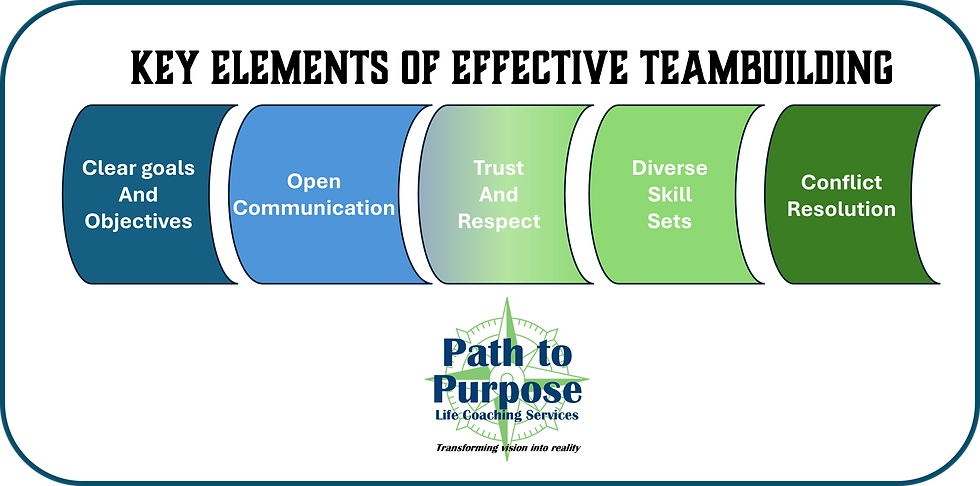Unlocking the Secrets of Effective Teambuilding Strategies
- Julia Bruce
- Sep 19, 2025
- 4 min read
Teambuilding is more than just a buzzword; it is an essential part of creating a productive and pleasant work environment. Strong teambuilding strategies can turn a group of individuals into a united team that works towards shared goals. In this blog post, we will explore the powerful impact of effective teambuilding, offering insights and practical strategies to boost collaboration and communication in teams.
Understanding the Importance of Teambuilding
Teambuilding plays a critical role in several key areas. First, it enhances communication among team members. Research shows that teams with strong communication are 25% more productive. When individuals feel comfortable sharing their thoughts and ideas, collaboration flourishes, leading to innovative solutions.
Additionally, effective teambuilding builds trust and respect within the team. When people set and strive for common goals, they develop camaraderie and cooperation, which can lead to a 30% improvement in job satisfaction. It also creates a supportive environment that encourages creativity and collaboration.
Lastly, cohesive teams are more adaptable. They can navigate challenges and changes more effectively than fragmented groups. According to a study by the Institute for Corporate Productivity, teams that engage in regular teambuilding activities are 22% more likely to remain resilient during tough times.

Key Elements of Effective Teambuilding
1. Clear Goals and Objectives
A crucial aspect of effective teambuilding is setting clear goals and objectives. Teams must know what they are working towards to align their efforts effectively. Using SMART goals—specific, measurable, achievable, relevant, and time-bound—provides a clear roadmap. For example, rather than a vague goal like "improve sales," aim for "increase quarterly sales by 15% by the end of Q3." This clarity helps team members focus and fosters a sense of purpose.
2. Open Communication
Open communication is the heartbeat of any successful team. Encouraging team members to share their thoughts, ideas, and concerns creates an atmosphere of transparency. Regular check-ins, feedback sessions, and open-door policies foster this culture. When team members feel heard, they are 50% more likely to engage actively with their colleagues and contribute to team success.
3. Trust and Respect
Trust and respect are foundational for effective teambuilding. Building trust takes time, but it is vital for strong relationships. Team-building activities that promote collaboration and understanding can help. For example, a workshop focused on empathy can significantly enhance mutual respect, leading to a more harmonious and productive workplace.
4. Diverse Skill Sets
Teams benefit greatly from having members with diverse skill sets. A mix of backgrounds, skills, and experiences leads to innovative solutions. For instance, a report by Deloitte found that diversity in teams can improve performance by up to 35%. Encouraging team members to share their unique strengths can greatly enhance collaboration and lead to better outcomes.
5. Conflict Resolution
Conflict is a natural part of any team. However, how a team manages conflict can significantly affect its success. Establishing clear conflict resolution processes helps teams navigate disagreements constructively. For example, training sessions on conflict resolution can empower team members to focus on solutions rather than blame, fostering a positive team dynamic.
Practical Teambuilding Strategies
1. Team-Building Activities
Participating in team-building activities can strengthen relationships and improve teamwork. These activities can vary from simple icebreakers to complex problem-solving exercises. Organizing regular events, such as escape rooms or outdoor challenges, can allow team members to bond outside of their daily work.
2. Workshops and Training
Investing in workshops and training can enhance the team's skills and knowledge. Sessions focusing on communication, conflict resolution, or specific technical skills relevant to team objectives are beneficial. A 2021 LinkedIn report revealed that teams that engage in continuous learning see a 20% increase in overall productivity.
3. Recognition and Rewards
Recognizing and rewarding team achievements can significantly boost morale. Celebrating milestones, both big and small, creates a strong sense of accomplishment. Consider establishing a recognition program that regularly highlights individual and team contributions. Companies that implement recognition programs see a 31% reduction in turnover rates.
4. Regular Feedback
Creating a feedback-driven culture can greatly enhance team dynamics. Regularly asking for feedback from team members helps identify areas for improvement. Constructive feedback can lead to personal and professional growth, which boosts overall team performance.
5. Social Interactions
Encouraging social interactions among team members strengthens relationships. Hosting informal gatherings, like team lunches or outings, allows team members to connect personally. Such interactions pave the way for better communication and teamwork.

Measuring the Success of Teambuilding Efforts
To determine the effectiveness of teambuilding strategies, measuring their impact is essential.
1. Employee Engagement Surveys
Conducting employee engagement surveys can offer valuable insights into team dynamics. These surveys assess satisfaction, communication, and collaboration levels. According to Gallup, teams with high engagement can improve productivity by 21%. Analyzing survey results can help pinpoint areas needing improvement.
2. Performance Metrics
Tracking performance metrics can also provide evidence of teambuilding success. Monitoring productivity, project completion rates, and team performance reveals the tangible effects of effective teambuilding. Companies that track these metrics see an average team performance increase of 10% annually.
3. Feedback from Team Members
Collecting feedback from team members about their experiences with teambuilding activities offers additional insights. Understanding what worked well helps refine and improve future initiatives.
Final Thoughts
Effective teambuilding is a powerful strategy that can transform a group of individuals into a cohesive and productive team. By focusing on clear goals, open communication, trust, and respect, organizations can create a setting where collaboration thrives.
Implementing practical teambuilding strategies—like engaging activities, workshops, and recognition programs—can further enhance team dynamics.
Investing in teambuilding signifies an investment in the organization’s success. By mastering effective teambuilding strategies, teams can tackle challenges, innovate, and achieve their goals together.




Comments